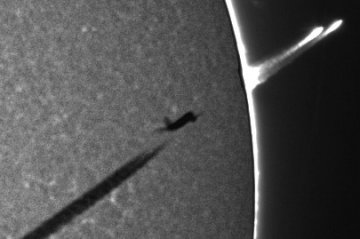 Where's Saturn? Is that a UFO--or the ISS? What's the name of that star? Get the answers from mySKY--a fun new astronomy helper from Meade. Where's Saturn? Is that a UFO--or the ISS? What's the name of that star? Get the answers from mySKY--a fun new astronomy helper from Meade. ALERT: A moderate geomagnetic storm is underway. High latitude sky watchers should be alert for auroras. THANKSGIVING SKIES: Thanksgiving is the biggest travel holiday of the year in the United States. Millions of people board airplanes and fly long hours to visit friends and family. Dreading the trip? Think of it as a sky watching opportunity. There are some things you can see only through the window of an airplane: full story. BEWARE THE JELLYFISH: "Comet Holmes (appearing as 'The Jellyfish') has Mirfak in its tentacles!" reports Derek Java who sends this picture from Glens Falls, New York: 
Readers agree, Mirfak looks like its being swallowed by a celestial sea monster. In fact, Comet Holmes is just passing in front of the star and the star is shining back through the comet's translucent atmosphere. This encounter will continue for several nights to come, so point your telescope and enjoy the meal. Comet 17P/Holmes Photo Gallery
[Interactive World Map of Comet Photos]
[sky map] [ephemeris] [3D orbit] [Night Sky Cameras] AIR PROMINENCE: When solar activity is low, what does a solar astronomer do? Wait for an airplane! During the weekend, astronomers at the Pic du Midi observatory in France were photographing the quiet sun when a jet liner flew by to break the monotony: 
Photo credit: Jean-Louis Levieil, Michel Pujol, Pic du Midi CLIMSO coronagraph
This composite image shows the plane when it was crossing in front of the sun and a moment later when it was past the edge. "At first we thought there was an eruption on the limb," says Pic du Midi software engineer David Romeuf. But it was just sunlight shining through the jet's turbulent contrail. The sun is quiet again. Fortunately, says Romeuf, "we get lots of planes." | 
